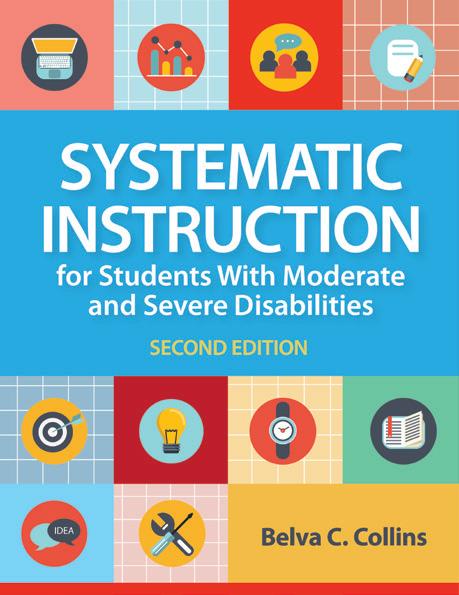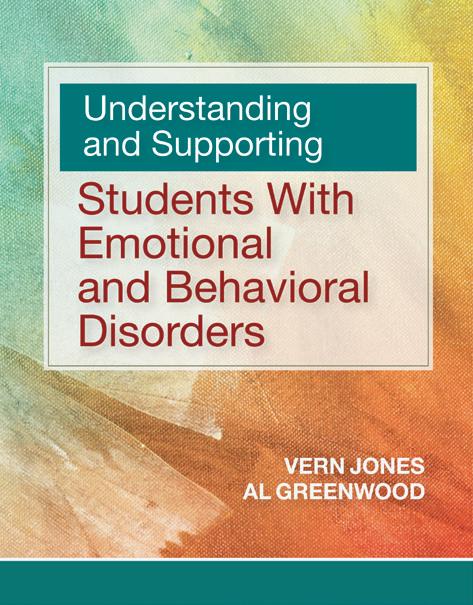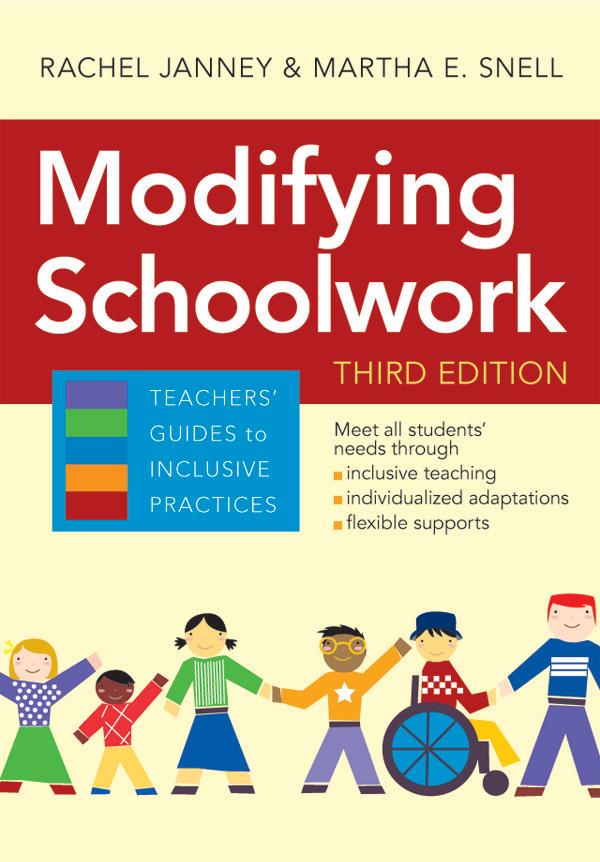
16 minute read
Implementing MTSS: Voices from the Field



Modifying Schoolwork
Third Edition
By Rachel Janney, Ph.D. (independent scholar and consultant), Martha E. Snell, Ph.D. (University of Virginia)
—Martha Thurlow, Director of the National Center on Educational Outcomes
Your students will keep and use this quick, practical, ready-to-use guidance on teaching all students—and making appropriate modifications for kids who need extra support. This third edition of the bestselling book in the Teachers’ Guides to Inclusive Practices series gives future teachers a clear and concrete plan for K-12 inclusion. Packed with field-tested strategies, case studies, and planning tools, this hands-on guide will show preservice teachers how to deliver effective universal instruction in core content areas and create customized adaptations and flexible supports for students with diverse needs and abilities. The next generation of teachers will learn what really works in inclusion, and they’ll discover how to seamlessly weave in modifications while encouraging each student’s sense of belonging.
IN THIS EDITION: • Practical guidance on implementing Universal Design for Learning • Content aligns clearly with an RTI framework, with strategies spanning from whole-class instruction to highly individualized adaptations • More on working with students with significant disabilities and complex learning needs—one of the biggest challenges of inclusion • Easy-to-print forms that help teachers plan individualized supports and adaptations, available at www.brookespublishing.com • Helpful “focusing questions” at the start of each chapter—perfect for preservice study and teacher book club discussions • New stories from teachers and parents that spotlight real-world challenges and successes
INCLUDES PRINTABLE PLANNING TOOLS: • Team Roles and Responsibilities Checklist • Program-at-a-Glance • Student Profile • General Assessment of Classroom Activities • Program Planning Matrix • Individualized Adaptations and Support Plan
ORDER EXAM COPY
CONTENTS
1. Inclusive Education: The Big Picture 2. Curricular and Instructional Practices that Promote the Inclusion and Success of All Students 3. A Model for Creating Individualized Adaptations and Supports 4. Planning, Implementing, and Evaluating
Individualized Adaptations and Supports for
Students with Extensive Needs 5. Including All Students in Instruction in Core
Curriculum Areas
Appendix A: Blank Forms Appendix B: Resources on Creating Effective Inclusive Schools and Designing Schoolwork for Inclusive Classrooms

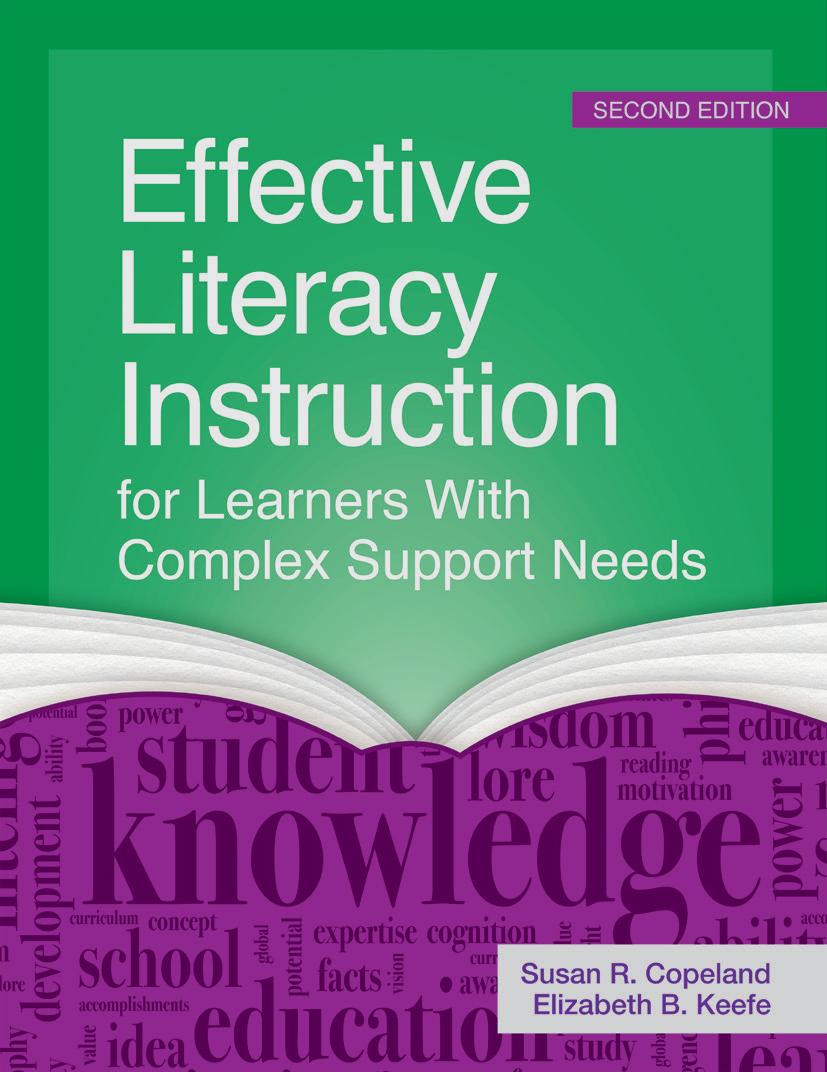
ORDER EXAM COPY

CONTENTS
I. THE FOUNDATIONS OF LITERACY AS
A HUMAN RIGHT 1. Literacy for All 2. Developing Language and Communication 3. Addressing Cultural and Linguistic Diversity in
Language and Literacy Instruction 4. Inclusive Literacy Instruction: State and National
Standards and Beyond 5. Creating Accessible, Rich and Engaging Literacy
Environments II. EVIDENCE-BASED COMPREHENSIVE LITERACY
INSTRUCTION 6. Getting the Point: Comprehension Instruction 7. A Broader Approach to Fluency 8. Words, Glorious Words! 9. What’s the Word? Word Recognition Instruction 10. Conveying Your Message: Writing Instruction 11. Organizing Effective Literacy Instruction:
A Framework for Planning III. CREATING OPPORTUNITY AND ACCESS TO
LITERACY IN SCHOOL AND BEYOND 12. Adapting Books and Other Literacy Genres 13. Beyond the Common Core: Art, Music, And
Creativity in Literacy Learning 14. Literacy Beyond High School 15. Where Do We Go from Here?

Effective Literacy Instruction for Learners with Complex Support Needs
Second Edition
Edited by Susan R. Copeland, Ph.D., BCBAD (University of New Mexico), & Elizabeth B. Keefe, Ph.D. (University of New Mexico)
What are today’s best methods for teaching literacy skills to students with complex support needs—including autism, intellectual disability, and multiple disabilities? This comprehensive guidebook has up-todate, evidence-based answers for pre- and in-service educators.
Developed by Copeland and Keefe, the experts behind the landmark book Effective Literacy Instruction for Students with Moderate or Severe Disabilities, this thoroughly reimagined follow-up reflects 10 years of ground-breaking research and advances in the field. You’ll discover current recommended practices on critical topics, including how to build vocabulary, increase word recognition, enhance fluency, address cultural and linguistic diversity, and use academic standards when designing instruction. You’ll also get the guidance you need to put theory into practice: lesson planning strategies, practical examples, and case studies that bring key principles of instruction to life.
Whether used as a text for teachers in training or a guide for practicing educators, this book will help teachers of Grades K–12 increase access to literacy and prepare all learners for successful communication, employment, and community life.
IN THIS EDITION: • New section on literacy as a human right for all learners (the
“why” of instruction) • Chapters on how to design engaging learning environments • Cutting-edge guidance on today’s assistive technology and augmentative and alternative communication • A dedicated chapter on how to use national and state standards in designing instruction • Recommendations for adapting books and other materials to increase all learners’ access • Chapters on combining literacy and the arts to enhance student engagement • More on literacy beyond high school, including community-based learning opportunities
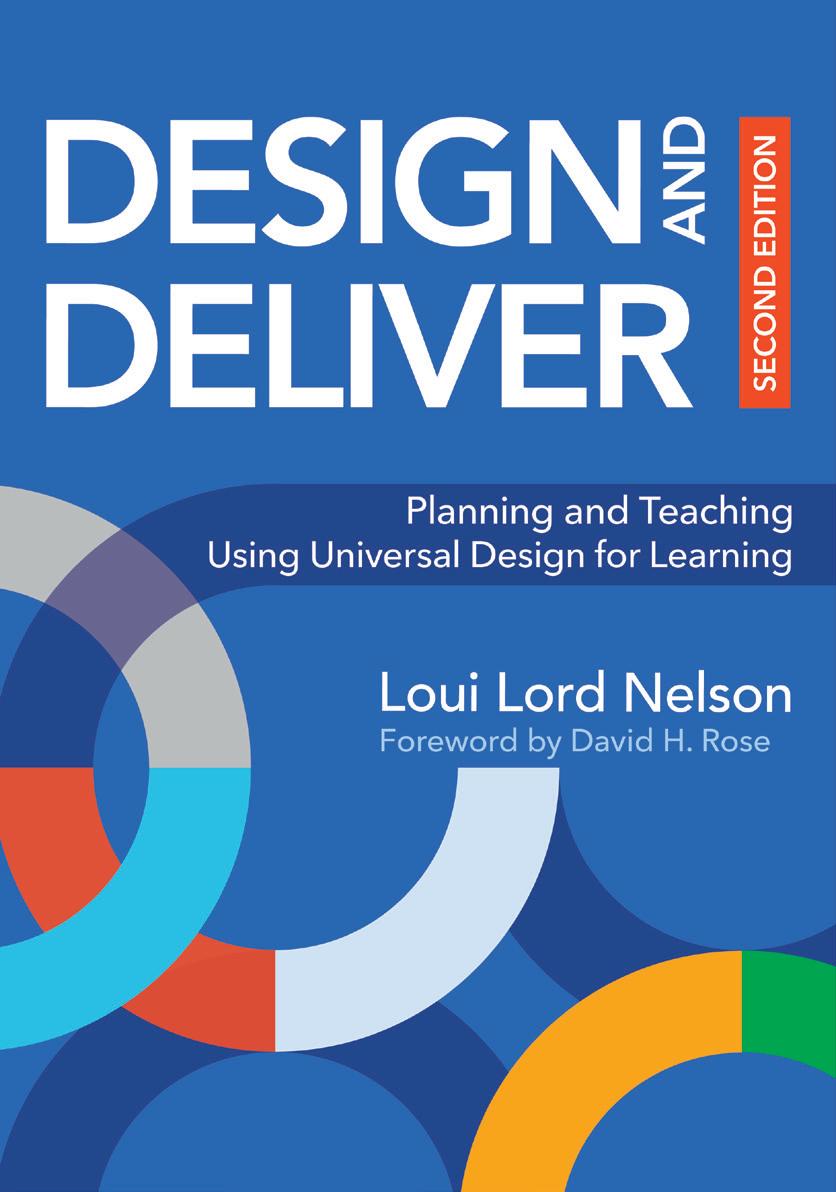



Design and Deliver
Planning and Teaching Using Universal Design for Learning, Second Edition
By Loui Lord Nelson, Ph.D. (Educational Consultant and Owner, The UDL Approach)
—Dr. Ron B. Rogers, Director of the UDL Center at OCALI
Universal Design for Learning (UDL) is the best way to teach all students effectively and break down barriers to learning—but how can future teachers get started with UDL when they enter the classroom? The answers are in the second edition of this bestselling, teachertrusted primer, created by internationally recognized UDL expert Loui Lord Nelson.
Thoroughly updated to reflect new research and developments in the field of UDL, this text gives tomorrow’s K–12 teachers a reader-friendly UDL introduction and a practical framework for implementation, with guidelines and checkpoints for designing effective, barrier-free lesson plans and learning environments. Your students will learn how to use the three core principles of UDL—Engagement, Representation, and Action & Expression—to present information in multiple ways and ensure access for all learners. Throughout the book, detailed examples, stories, illustrations, teacher reflections, and activities reinforce UDL principles and help teachers put them into practice in both virtual and in-person settings.
WHAT’S NEW: • Key insights from the latest neuroscience research • Useful stories and practical tips from teachers implementing UDL • Technology bytes: timely tips and ideas on how to enhance online learning with UDL • Expert guidance on current topics, including culturally responsive teaching, urban education, and a focus on the expert learner • “Ponder this” prompts throughout the book to help readers consider new ideas and discover additional resources • End-of-chapter “check-ins” that help readers apply what they’ve learned
ONLINE MATERIALS: Designing instruction with UDL is easier than ever with these online resources, available as printable downloads: CAST UDL Guidelines; an Identifying Your Resources chart; a UDL design cycle graphic; a UDL lesson plan flowchart; and classroom resource mapping charts for elementary, middle, and high school teachers.
ORDER EXAM COPY
CONTENTS
I. INTRODUCING UNIVERSAL DESIGN
FOR LEARNING 1. Introducing Universal Design for Learning 2. The Must-Knows of the UDL Framework II. THE PRINCIPLES OF UNIVERSAL DESIGN
FOR LEARNING 3. Engagement 4. Representation 5. Action and Expression III. FROM PLANNING TO PRACTICE 6. The Learning Environment 7. The Goal and the Lesson

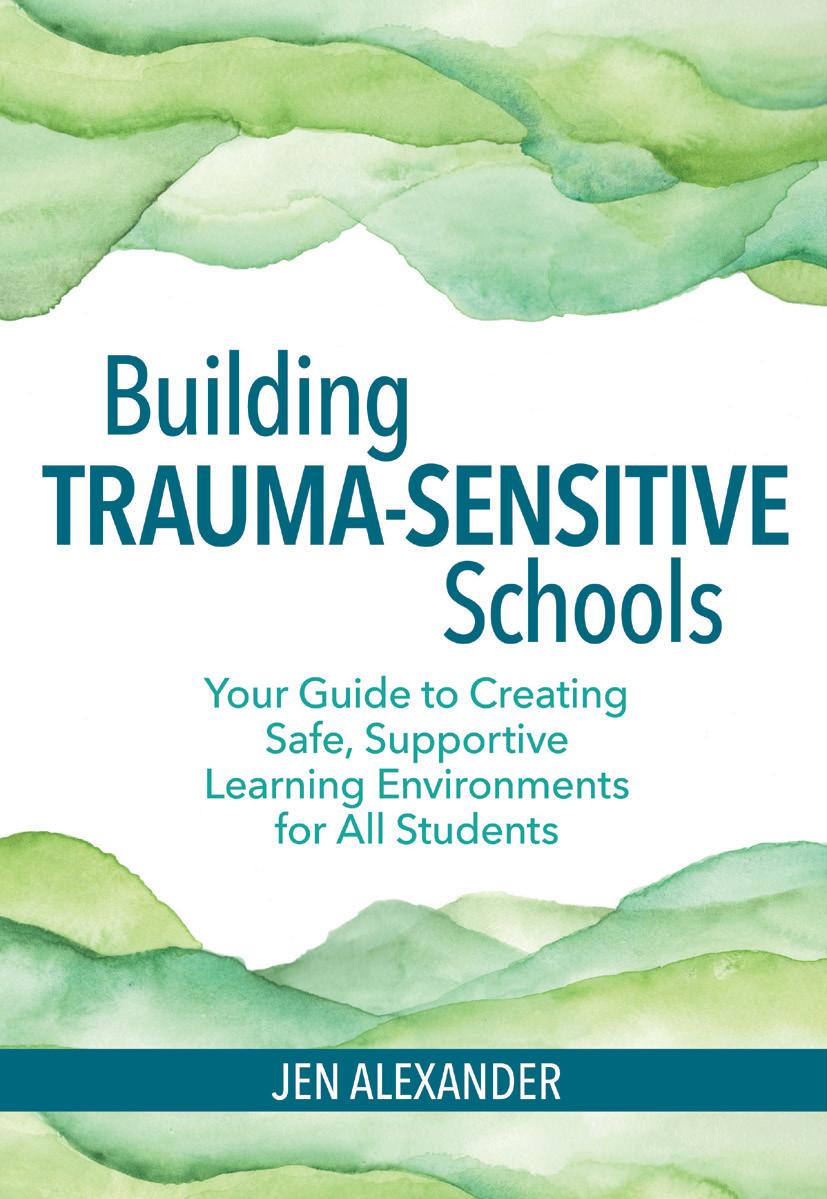
ORDER EXAM COPY

CONTENTS
I. UNDERSTANDING TRAUMA 1. Trauma and Its Effects 2. The Role of Attachment in Development 3. Trauma’s Impact on Youth at School II. BUILDING TRAUMA-SENSITIVE SCHOOLS 4. The Trauma-Sensitive School Framework 5. Paradigm Shifts 6. Essentials of Trauma-Sensitive Schools III. IMPLEMENTING TRAUMA-SENSITIVE STRATEGIES 7. Universal Strategies for Trauma-Sensitive Schools 8. Supplemental and Intensive Trauma-Sensitive
Interventions 9. The PACE Approach to Working With Traumatized
Students 10. Trauma-Sensitive Discipline Practices 11. Self-Care for Educators

Building Trauma-Sensitive Schools
Your Guide to Creating Safe, Supportive Learning Environments for All Students
By Jen Alexander, M.A., NCC, SB-RPT
—Jody McVittie, Executive Director, Sound Discipline
In the United States, at least one in four youth experiences trauma severe enough to negatively affect their school success.* Get future educators ready to support students with this ideal supplemental textbook, a reader-friendly springboard for building responsive, trauma-sensitive preK–12 schools. Drawing on her experience as a school counselor, trainer, and mother, Jen Alexander delivers a comprehensive framework for building a supportive school environment that helps all students thrive. Your students will start with an evidence-based introduction to the impact of trauma on a child’s development, attachment, and behavior. Then they’ll get an effective multi-tier system of support (MTSS) for developing a trauma-sensitive learning environment, including both universal strategies (Tier 1) and more intensive interventions (Tier 2 and Tier 3) for students who need more support. PREPARE EDUCATORS TO: • Make five key shifts in the way they view and approach students, so that they’re better equipped to provide support • Implement universal instructional strategies that foster safety, connection, regulation, and learning • Use special supports and coaching when universal strategies aren’t enough • Collaborate effectively with families and colleagues to meet each student’s needs • Incorporate restorative discipline practices that focus on restitution, not retribution • Create a personalized self-care plan to reduce the effects of job-related stress
PRACTICAL MATERIALS: Creative activities for teachers, powerful case stories, sample dialogues and scripts, reflection and brainstorming worksheets, downloadable forms, a sample syllabus, and handouts for use in the classroom.



Pivotal Response Treatment for Autism Spectrum
Disorders, Second Edition
Edited by Robert L. Koegel, Ph.D. (Stanford University School of Medicine), & Lynn Kern Koegel, Ph.D. (Stanford University School of Medicine), with invited contributors
The pioneering experts behind Pivotal Response Treatment have created a comprehensive modern guide to this highly respected, research-based approach, completely reworked and revised for a new generation of therapists and educators. Strengthened with new research and more step-by-step guidance, this bestselling PRT text is now reorganized to support children on their whole developmental trajectory, from infancy through adulthood. New and revised chapters cover critical topics—including assessment and self-management— and the book’s down-to-earth, accessible style ensures that your students can grasp PRT principles and apply them effectively.
With this proven approach backed by more than 25 years of research, future professionals will be ready to support children with autism as they enjoy more positive interactions, more effective communication, and higher academic achievement.
USE THE PROVEN PRT APPROACH TO: • Advance children’s communication and language skills • Aid early identification and intervention • Improve children’s motivation and performance in school • Foster friendships with peers during play dates and other social interactions • Increase positive behavior by combining functional assessment and self-management strategies • Decrease disruptive behavior • Help young adults make a smooth transition to college, career, and community life
PRACTICAL MATERIALS: Each chapter features learning goals, key insights to remember, and helpful study questions (also available online to download and print).
WHAT’S NEW: New and completely reworked chapters on working with infants and toddlers, linking strengths-based assessment to treatment planning, improving adolescents’ communication and social skills, teaching parents how to implement PRT, combining functional behavioral assessment and self-management strategies, helping young adults succeed in college and the workplace.
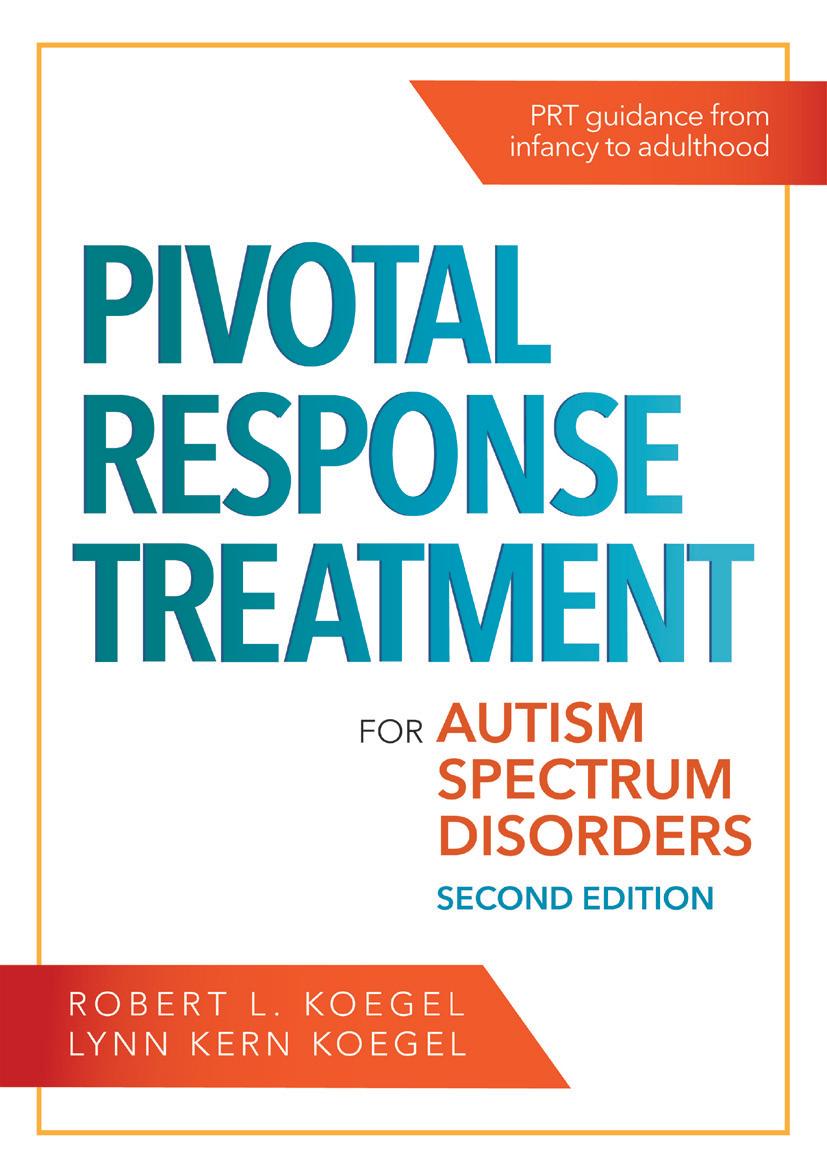
ORDER EXAM COPY
CONTENTS
I. OVERVIEW: PIVOTAL RESPONSE TREATMENT IN
CONTEXT 1. The History and Basic Components of Pivotal
Response Treatment 2. Assessment, Feedback, and Treatment Planning 3. Ecocultural Theory and Cultural Diversity II. BEGINNING STAGES: EARLY INTERVENTION 4. Intervention for Infants and Young Toddlers 5. Teaching First Words 6. Expanding Friendship Opportunities for Children with ASD III. CHILDHOOD: TREATMENT OPTIONS AT HOME
AND AT SCHOOL 7. Parent Education in Pivotal Response Treatment 8. Inclusive Education 9. Motivational Academics IV. ADOLESCENCE AND YOUNG ADULTHOOD: MOV-
ING TOWARD INDEPENDENCE 10. Functional Behavior Assessment and
Self-Management 11. Improving Communication Skills in Adolescents and Adults with ASD 12. Improving Socialization in Adolescents and Adults with ASD V. ADULTHOOD: HIGHER EDUCATION
AND EMPLOYMENT 13. Improving Outcomes in Higher Education for
Adults with ASD 14. Supporting Individuals with ASD in Employment
Settings

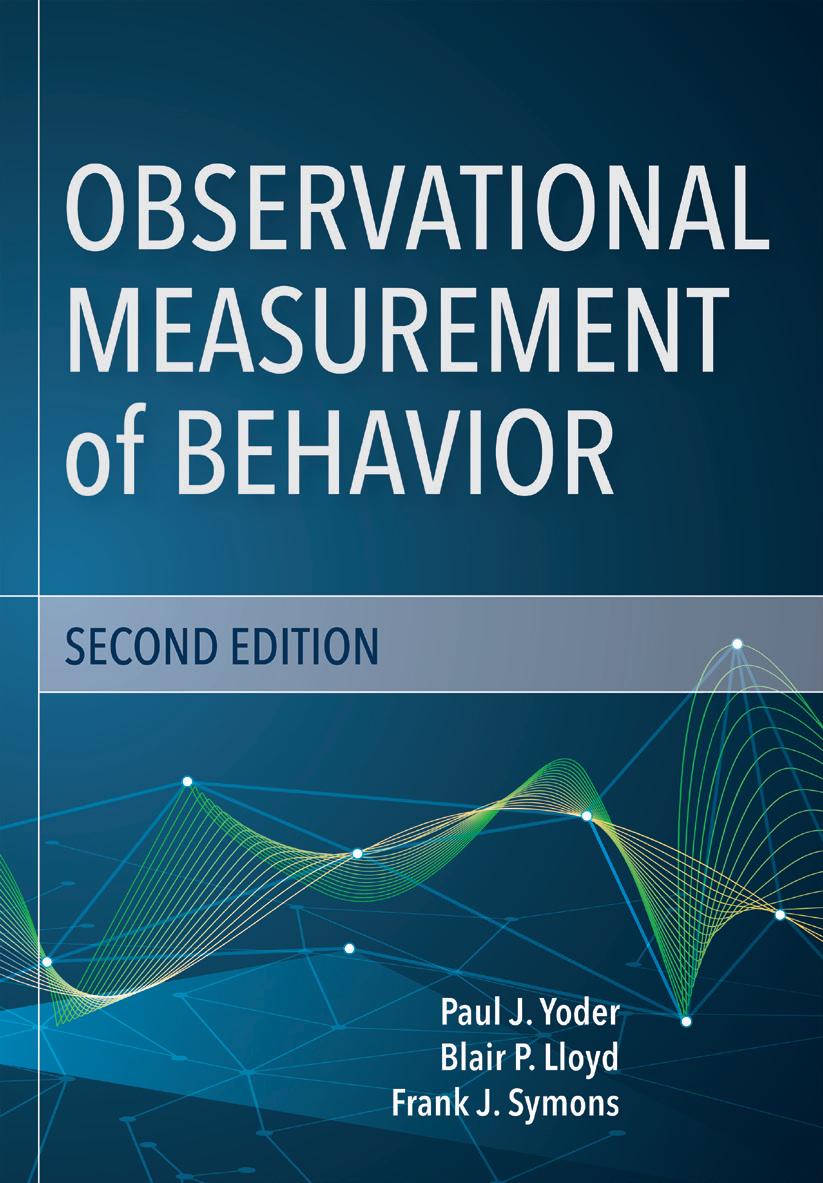
ORDER EXAM COPY

CONTENTS
I. FOUNDATIONAL TOPICS 1. Introduction to Systematic Observation and
Measurement Contexts 2. Validation of Observational Variables 3. Estimating Stable Measures of Generalized Person
Characteristics Through Systematic Observation 4. Designing or Adapting Coding Manuals 5. Coding 6. Common Metrics of Observational Variables 7. Observer Training and Preventing Observer Drift 8. Interobserver Reliability of Observational Variables II. ADVANCED TOPICS 9. Introduction to Sequential Analysis 10. Research Questions Involving Sequential
Associations 11. Generalizability Theory III. PUTTING IT ALL TOGETHER 12. Summary of Recommendations for Best Practices in Observational Measurement

Observational Measurement of Behavior
Second Edition
By Paul J. Yoder, Ph.D. (Vanderbilt University), Blair P. Lloyd, Ph.D., BCBA-D (Vanderbilt University), & Frank J. Symons, Ph.D. (University of Minnesota) An essential textbook for anyone preparing to be a researcher, this comprehensive volume introduces graduate students to key principles of observational measurement of behavior. Based on a course the highly respected authors taught at Vanderbilt University and the University of Minnesota, this text delves deeply into a highly effective approach to observational measurement: systematic observation.
Students will master both the theoretical principles of systematic observation and recommended research methods and techniques. They’ll learn from practical examples that illustrate complex concepts, clear explanations of recommended research methods, definitions of key terms, and exercises and assignments that help them practice putting principles into action. Online companion materials include two six-month licenses for proprietary observational software that students can use to complete the exercises and assignments in this book.
Ideal for use in research methodology courses in diverse fields—including special education, communication sciences, psychology, and social work—this fundamental graduate text will prepare future researchers to skillfully collect, summarize, and communicate their observations of children’s behavior.
STUDENTS WILL: • Fully understand key methods of observational research and measurement • Get comprehensive information on both foundational and advanced topics • Learn from real-world examples based on the authors’ experience • Apply specific recommendations for effective techniques and best practices ONLINE COMPANION MATERIALS: To enhance their courses, instructors will get a full package of online materials, including two six-month licenses for observational software, a media file students can use to practice coding behaviors, a suggested schedule for a semester-long course, exercises for students, and assignments with corresponding grading rubrics.
US$59.95 | Stock #: 52469 | 2018 | 272 pages | 7 x 10 | paperback | ISBN 978-1-68125-246-9
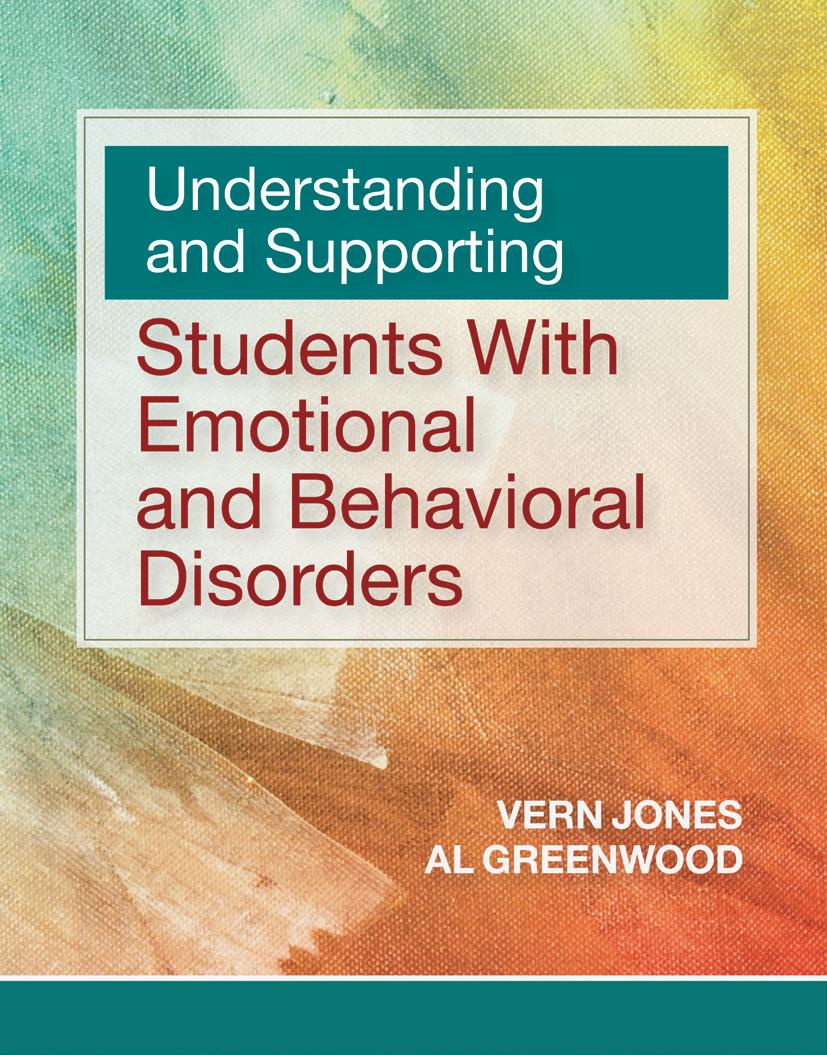



Understanding and Supporting Students with Emotional and Behavioral Disorders
NEW
By Vern Jones, Ph.D., & Al (Skip) Greenwood, Ph.D. Students who experience serious emotional and/or behavioral disorders (EBD) are at risk for a wide range of negative outcomes, from limited academic progress to problems with employment and community life after they leave school. Positive educational experiences can help, and this textbook fully prepares educators, school psychologists, and administrators to create supportive K–12 learning environments that help students with EBD thrive. This comprehensive text gives future professionals a deep understanding of the key issues associated with EBD and practical, trauma-informed approaches for working with these students in a variety of settings, from general education classrooms to specialized intervention programs. Your students will discover how to:
• Recognize key factors that influence each student’s behavior, such as developmental history, personal characteristics, skill sets, and social perceptions • Help students develop positive, supportive personal relationships with adults and peers in the classroom • Deliver meaningful, engaging instruction within safe and supportive learning environments • Involve students in creating behavioral standards that support engagement in instruction • Develop effective behavior support plans that include assessment and intervention • Respond with proven strategies when students fail to follow established behavior standards • Engage students in problem solving and conflict resolution • Implement social–emotional learning strategies that help break down obstacles to school success • Develop and assess a program that provides specialized support in a more contained setting for students with more intensive needs • Create a plan for staff development and support of staff working in programs for students with EBD Special features throughout the book—such as chapter outcomes, summaries, reflection activities, forms, sample lessons, checklists, and case studies—ensure comprehension and help future professionals successfully implement the concepts and methods in their daily work. Also included is a complete package of online companion materials for faculty, featuring PowerPoint slides, a test bank, and sample syllabi.
ORDER EXAM COPY
CONTENTS
1. Key Concepts and Assumptions Related to Effective Support for Students with Emotional And
Behavioral Disorders 2. Developing A Foundational Understanding of
Emotional and Behavioral Disorders 3. Creating Supportive Adult–Student and Peer Relationships 4. Developing Behavior Standards and Increasing
Students’ Motivation to Learn 5. Responding Effectively to Disruptive Behavior 6. Developing Individualized Behavior Support Plans:
Planning for Student Success 7. Social-Emotional Learning Methods for Supporting Student Success 8. Developing an Effective Program for Students
Identified as EBD

ORDER AN EXAM COPY TODAY
ORDER EXAM COPY

You can request exam/desk copies of up to two books that are relevant to your course needs. If you see a book in this catalog that you’re interested in previewing, please look it up on www.brookespublishing.com, click the Request Exam Copy button found on the book’s page, and complete the request form. (All requested information must be supplied before we can process your order.)
GET COMPANION MATERIALS
The Brookes Download Hub is your home base for the online course materials— slides, test banks, sample syllabi, and more—that come with Brookes books. Sign up with your faculty email address to download companion materials, “favorite” your books to keep track of your online materials, and get free access to companion materials for ALL Brookes books. Registration is easy—sign up today! https://downloads.brookespublishing.com

Brookes Publishing Co. P.O. Box 10624 Baltimore, MD 21285-0624
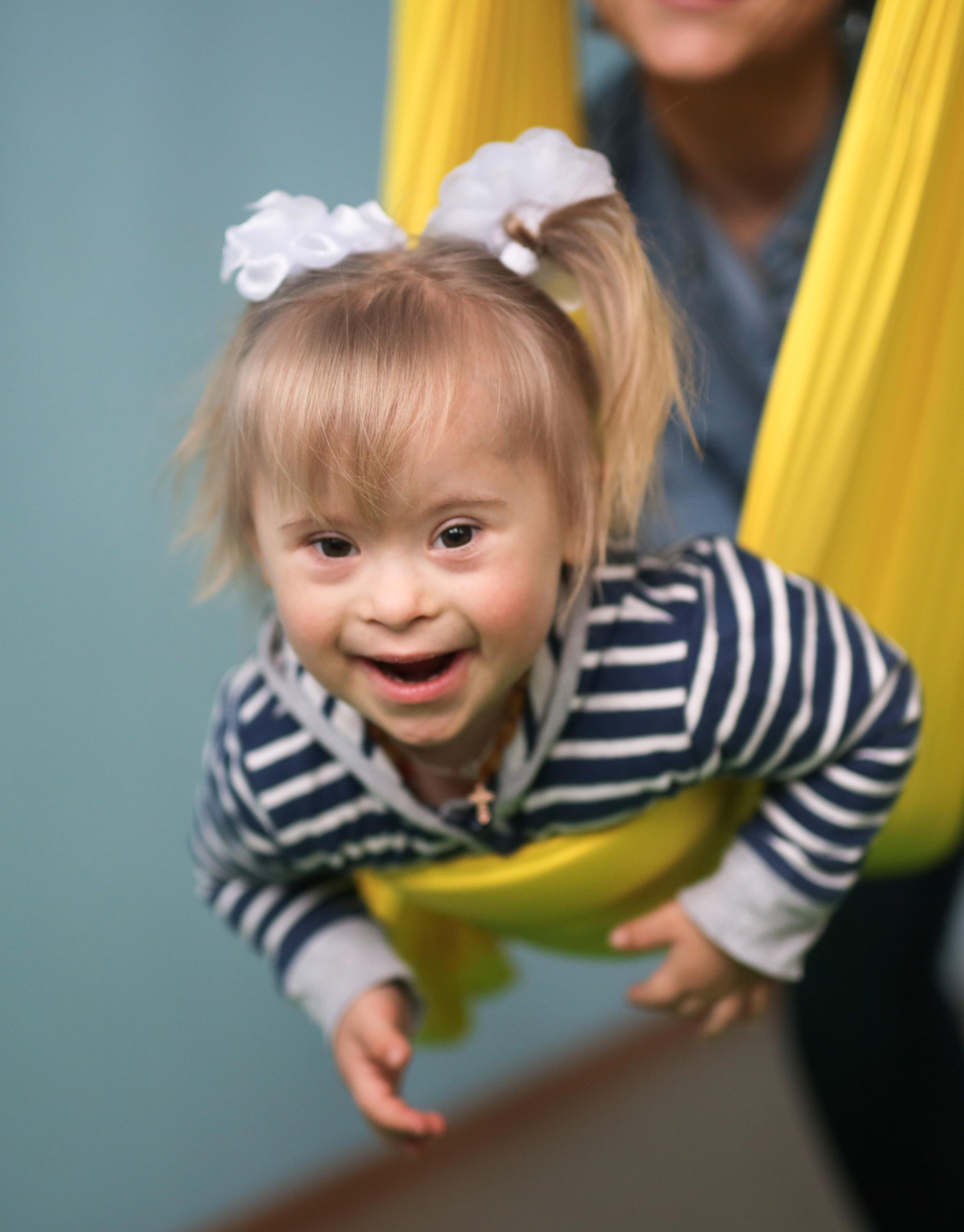
PAGE 4 PAGE 3 PAGE 23
